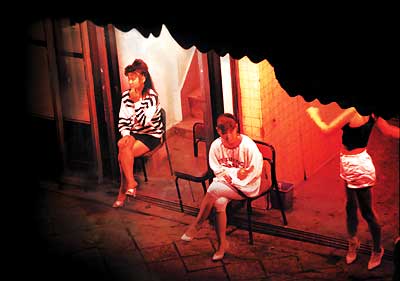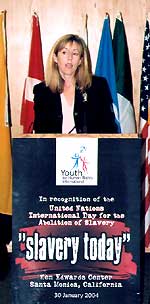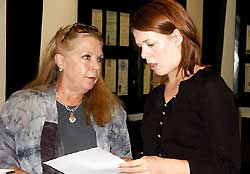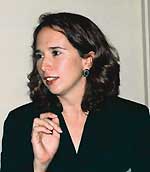
Putting a Stop to the Exploitation
Concerned human rights activists unite to end the scourge of sex slavery across all borders
By Tom Paquette
 FEDERAL PROSECUTOR CAROLINE WITTCOFF: “Under-reporting is the main problem in apprehending and prosecuting human traffickers. Victims are afraid to run away or report their captors to authorities out of fear for their own lives or the lives of their loved ones. As trafficking rings have ties all the way back to their home countries, this is a very real danger.” |
This is just one of the stunning, real-life anecdotes recounted in a series of “Slavery Today” panel discussions on the multibillion-dollar human trafficking industry which, experts say, has grown to epidemic levels in Southern California.
The panels, sponsored by the Foundation for Human Rights and Tolerance and held in Hollywood, recognized the United Nations International Year to Commemorate the Struggle Against Slavery and its Abolition. At the kick-off event, Lynsey Bartilson, star of the WB network’s “Grounded for Life,” told attendees, “The modern day slave trade is largely sexual trafficking, which Hollywood glamorizes in movies like ’Pretty Woman,’ but the harsh reality is that most of the girls involved are sold into a life of slavery.”
The discussions are designed to expose the inhumanity of today’s $19 billion-a-year sex slave trade.
An international spokesperson for the Foundation-sponsored Youth for Human Rights International, Bartilson explained to her audience of community and religious leaders, journalists and student activists that sex trafficking is “one of the biggest violations of human rights on the planet today, yet the issue is largely buried and rarely covered in the media.” As a result, Bartilson has made it her mission to help expose—and end—the practice.
 AT THE OPENING OF THE FIRST “SLAVERY TODAY” CONFERENCE, Marisa Ugarte, founder and director of the Bilateral Safety Corridor Coalition in San Diego, showed how news media have begun to bring home the size and scope of the sex trade along the U.S.-Mexico border. Above, she discusses media coverage of human trafficking issues with “Grounded for Life” star Lynsey Bartilson (right), international spokesperson for Youth for Human Rights International. |
Speakers joined her in bringing to life the controversial and little-known global scourge of modern slavery: the illegal recruitment, transport, harboring, sale, receipt or transfer of women, children and men into enslavement for forced prostitution, labor or sexual servitude. Criminal gangs operate through suppliers in one country who entrap the females, often through false promises of better working conditions, and pass them on to traffickers in another country.
“Slavery Today” conference participants examined the current measures taken to combat this evil and propose new solutions to the problem. “Slavery is not just a history lesson,” says Mary Shuttleworth, founder of Youth for Human Rights International.
Joining her and Bartilson for the series of panels have been top local and national human rights advocates and sexual trafficking experts, including Lisa L. Thompson, the Salvation Army’s national consultant for youth development liaison for the abolition of sexual trafficking; Jennifer Stanger, national training director for the Coalition to Abolish Slavery & Trafficking (CAST; see “A Life of Courage and Commitment,” page 40); Nancy Reyes-Rubi of the Legal Aid Foundation; Joseph K. Grieboski, president of the Washington, D.C.-based Institute on Religion and Public Policy; Katie Scolari Borden, Western USA regional manager for the UNICEF Fund; Marisa Ugarte, founder and executive director of the Bilateral Safety Corridor Coalition in San Diego; Caroline Wittcoff, federal prosecutor in the Los Angeles office of the United States Department of Justice; Janet Olson, president of Arizonans for the Protection of Exploited Children and Adults; and others.
 “People often use the term ’child prostitute’ to refer to children caught up in commercial sexual exploitation. These are prostituted children— children who are abused.”
“People often use the term ’child prostitute’ to refer to children caught up in commercial sexual exploitation. These are prostituted children— children who are abused.”
– Lisa L. Thompson Salvation Army |
|
 “Politicians on both sides of the aisle are united on the issue of human trafficking. Critical to backing up their efforts are the social services required to restore dignity to all victims.”
“Politicians on both sides of the aisle are united on the issue of human trafficking. Critical to backing up their efforts are the social services required to restore dignity to all victims.”
– Kay Buck Coalition to Abolish Slavery and Trafficking |
|
 “Slavery is always reinventing itself. For many of the children forced to work, the worst forms of abuse are the order of the day.”
“Slavery is always reinventing itself. For many of the children forced to work, the worst forms of abuse are the order of the day.”
– Katie Scolari Borden UNICEF |
By No Means “Just a Third World Issue”
CAST’s Jenny Stanger said today’s slavery is not just a third world issue, nor is it confined to the sex trade. It was alive and well right here on our doorstep, she said, citing slave labor stories such as that of the El Monte, California sweat shop, where 70 Thai women were forced to live and work behind barbed wire as they slowly paid off the factory owners who sponsored their trip to America.
The big hotels, she said, typically subcontract labor and some of these workers are little more than slaves. “Modern day slavery isn’t so much about being chained or incarcerated,” said Stanger. “It is about the psychological coercion that is used to trap the victims.”
“Many of the victims are peasant people from rural areas that want the American dream,” said Lou de Baca of the Department of Justice Civil Rights Division. “They want a ticket out—to be able to have a good job and send money back home.”
Methods used include confiscating passports, threatening family back home, and using illegal status to control them. Such individuals are often isolated from the society as a whole. Fear of the authorities, violence and threats are used to keep them working at their assigned tasks. CAST has opened a shelter to offer the exploited a place to go to escape from a lifetime of abuse.
Sadly, the problem is worsened by the confusion among the authorities between smuggling and trafficking, says Marisa Ugarte of the Bilateral Safety Corridor Coalition, which operates such shelters for trafficking victims across the Mexican-American border. Ugarte outlined the stark underbelly of the Southern California sex trade: American pedophiles visiting sexual tourism hot spots like Acapulco and Puerto Vallarta; gang members exploiting girls as a prime border town and export business; “young prostitutes with drugs in their mouths while they wait for the next trick.” Showing investigative news accounts on San Diego TV stations, she brought home the size and scope of the sex trade in rural San Diego County alone—farm workers lining up every week outside a bamboo tent filled with teenagers forced into a life of prostitution.
“We have to face the fact that there is corruption on both sides of the border,” she said.
Victims No Longer Need Be Powerless
Usually illegally smuggled into the country from Mexico, Russia, Eastern Europe or Asia, victims often do not speak English and have no idea of their geographical location. Their captors may tell them the police or immigration officials cannot be trusted and will kill them or deport them if they try to run away.
According to panelist Caroline Wittcoff of the U.S. Department of Justice, human trafficking is a complex crime whose perpetrators are difficult to prosecute. “Under-reporting is the main problem in apprehending and prosecuting human traffickers,” she said. “Victims are afraid to run away or report their captors to authorities out of fear for their own lives or the lives of their loved ones. As trafficking rings have ties all the way back to their home countries, this is a very real danger.”
|
“It’s a brutal trade, [an]
inhuman trade.... This country is determined to fight
and end this modern form of slavery.”
I was the one who had dared to challenge the system.”
– President George W. Bush |
So far, she says, community-based organizations have been the most responsive to the issue and provide the most assistance to victims.
Federal Government Initiatives
Too many women face violence and prejudice,” said U.S. President George W. Bush, in a March 2004 White House briefing on women’s human rights attended by the Salvation Army’s Lisa Thompson. “Many continue to live in fear, imprisoned in their homes. And in brothels, young girls are held against their will and used as sex slaves....”
The President re-asserted the U.S. government’s commitment to end sex trafficking—an objective shared by both ends of the political spectrum—which devoted nearly $75 million to eliminate worldwide trafficking in humans. “It’s a brutal trade, inhuman trade, by sick people that targets many women and girls. I spoke out against this practice at the United Nations [September 2003]. I called upon the world to join us. This country is determined to fight and end this modern form of slavery,” Mr. Bush told the White House women’s rights gathering.
As Kay Buck, CAST’s executive director, pointed out at the second “Slavery Today” conference, politicians left and right, and on both sides of the political aisle, are in fact united on the issue of human trafficking. Critical to backing up their efforts to eradicate this affront to human dignity, she says, are the needed social services required to restoring that dignity to all victims.
For more information on these ongoing “Slavery Today” conferences, contact Youth for Human Rights International, at (323) 663-5799 or visit www.youthforhumanrights.org.

